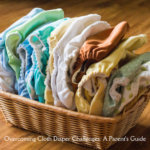In a world increasingly aware of environmental sustainability, more parents are turning to reusable diapers as a viable alternative to disposable ones. This guide will walk you through the essential steps of transitioning to reusable diapers, covering everything from the initial switch to ongoing maintenance and cost analysis.
Understanding Reusable Diapers
What Are Reusable Diapers? Reusable diapers, often made from natural fibers such as cotton, bamboo, or hemp, offer an eco-friendly alternative to disposables. They come in various styles, including all-in-ones, pockets, and prefolds, each designed for specific needs and comfort levels.
Benefits of Switching
- Environmental Impact: Significantly reduces waste and resource consumption.
- Cost-Effective: Major savings over the years compared to disposables.
- Health Benefits: Fewer chemicals on your baby’s skin.

Planning Your Transition to Reusable Diapers
Assessing Your Needs
- Lifestyle Considerations: Evaluate how reusable diapers fit into your daily routines.
- Budget Analysis: Calculate initial costs vs. long-term savings.
Setting Realistic Goals
- Gradual Transition: Start by replacing a few disposable diapers a day with reusables to ease the change.
Essential Supplies for Using Reusable Diapers
Building Your Stash
- Types of Diapers Needed: Quantity and variety based on washing frequency.
- Accessories: Wet bags, diaper sprayers, and cloth-safe diaper creams.
Table: Starter Kit for Reusable Diapers
| Item | Quantity | Purpose |
|---|---|---|
| Reusable Diapers | 20-24 | Daily use, allowing for laundry. |
| Wet Bags | 2-3 | For storing soiled diapers. |
| Diaper Sprayer | 1 | For rinsing off solids. |
| Cloth-Safe Cream | 1 tube | To protect baby’s skin. |
Mastering the Cleaning and Maintenance of Reusable Diapers
Cleaning Routine
- Storage: Keep soiled diapers in a dry pail with a lid.
- Washing: Use a cloth diaper-friendly detergent and perform a pre-rinse followed by a hot wash cycle.
- Drying: Line dry to extend the life of the diapers or use a dryer on low heat.
Troubleshooting Common Issues
- Odor Management: Regular stripping of diapers to remove buildup.
- Stain Removal: Natural sunlight is an effective bleaching agent.
Cost Analysis and Savings
Breakdown of Savings
- Initial Investment vs. Ongoing Costs: Detailed comparison of reusable versus disposable diaper expenses over two years.
- Long-Term Financial Benefits: Include potential savings over the diapering period of a child.
Cost-Saving Tips
- Buy Used: Purchasing secondhand diapers can reduce upfront costs.
- DIY Solutions: Consider making your own cloth wipes and solutions.
Personal Experience and Practical Advice
Family Insights As a father of three, the transition to reusable diapers was initially daunting, but it became second nature with a structured approach. Here are some tips:
- Engage Your Family: Get all caregivers on board for a smooth transition.
- Stay Organized: Keeping all diapering supplies in one accessible place helps manage changes efficiently.
Engaging with the Community
Support and Resources
- Online Forums: Places like Reddit and Facebook groups can offer support.
- Local Workshops: Some communities offer classes on cloth diapering.
Conclusion: Committing to the Change
Switching to reusable diapers is not just a lifestyle change but a commitment to your child’s future and the environment. With proper planning and execution, this transition can lead to significant benefits for your family’s health, finances, and ecological footprint.
This guide aims to equip you with the knowledge and tools needed to make an informed decision about reusable diapers, ensuring that your journey is as smooth and rewarding as possible.
HOW TO START WITH CLOTH DIAPERS: A BEGINNER’S GUIDE?
FRESH START: THE ESSENTIAL CLOTH DIAPER WASHING GUIDE







